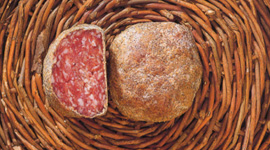Polenta 'Zuf' and pitina
Serves 4:
150 g pitina (Italian cold cut), butter (as needed), 200 g maize flour, water, salt
Method:
Cut the pitina into slices and heat it in a pan with a little butter. Meanwhile prepare the polenta. Add the flour to salted water and, while it is still liquid, transfer two ladles of this polenta'zuf' to the pan with the pitina, let everything dry and serve.
What is pitina?
This is a traditional product from the Val Tremontina. The recipe was probably based on the need to store meat in the autumn and winter in traditionally poor regions (such as the valleys north of Pordenone). It appears to have been prepared in the first half of the XVII century by the people who lived in the villages of Inglagna and Frasaneit, in the municipality of Tramonti di Sopra. It is very similar to peta and petuccia from the towns of Andreis and Claut respectively. Originally it was made only with goat's meat or sheep meat or game (chamois or roe deer).
The recipe was probably based on the sudden need to store game or if a goat or sheep was wounded or became ill suddenly. Nothing could be wasted. The need to preserve these meats led to pitina and its variants (peta and petuccia), which differ in the herbs added to the mixture. Peta is also bigger than pitina. Bones were removed and the meat was finely ground in a pestadora (a piece of wood in which a hollow had been carved). Salt, garlic and crushed black pepper were added. Small meatballs were made, rolled in maize flour and smoked on the 'fogher' shelf. Pitina would dry out over time, so it needed to be softened in polenta broth. Meatballs were made because it was often impossible to find casings to store the meat in. Preparing pitina does not require specialised equipment, so it could be made anywhere, even in the most isolated locations.
Today some pork fat is added to soften the intense (and slightly wild) taste of roe deer, goat or sheep meat. It is smoked with different kinds of wood, sometimes mixed (although beech is the main wood). Pitina is now eaten raw after seasoning for at least 30 days. It is also very good if cooked. It can be scalded in vinegar and served with polenta, sautéed in butter and onion and added to potato soup. It can be 'made in cao' (cooked in freshly milked cows' milk).
In 2000 it was included in the foods of the Slow Food association.


Via A. Altan 83/3
33078 San Vito al Tagliamento PN
docgrave@docfriuligrave.com
Tel: 0434.1836034
P.I. 00189540933
Utilizzo dei cookie